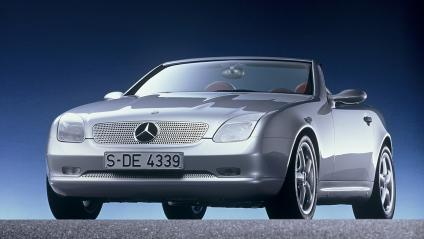1994 Mercedes-Benz SLK I / SLK II
- Story Cars

- Nov 16, 2021
- 4 min read

In 1994, Mercedes-Benz released two roadster visions: the SLK I and SLK II concepts.

SLK I Concept

SLK II Concept
The facts
Vehicle 1: SLK I concept
When: Spring 1994
Where: Turin Motor Show
Vehicle 2: SLK II concept
When: Fall 1994
Where: Paris Motor Show
What: Sporty roadster with compact dimensions and innovative roof
Powertrain: Four-stroke four-cylinder gasoline engine, rear-wheel drive, five-speed manual transmission
Ever since the 1950s, the letters "SL" have stood for a very special breed of Mercedes-Benz: sporty ("S"), light ("L") cars which were, for the most part, open-top roadsters. The SL series is now an established part of the range. By 1994 however, the time had come to air a new, compact version of the SL. The SLK concept made its debut in two stages. In spring 1994, it appeared at the Turin Motor Show. Already in near-production form, it still lacked a roof, however. That followed in the second SLK concept, which appeared a few months later at the Paris Motor Show. At the press of a button, the sensational electro-hydraulic "Vario roof" transformed the SLK from a convertible into a winter-proof coupe or vice versa in just 25 seconds. Mercedes-Benz was the first manufacturer to revive this type of roof, which harked back to an earlier era. When the SLK appeared as a production model in 1996 (R 170), its roof was such a hit that several competitors subsequently brought out versions of their own.
The SLK concept took various design cues from its imposing big brother, the SL, producing its variation on the latter's themes of elegance and dynamism. The result was styling that looked to the future while at the same time being firmly rooted in the tradition of the Mercedes-Benz brand. "Styling, which refers to nothing beyond current modernity, would not be Mercedes styling," said Design Chief Bruno Sacco. The face, the short overhangs front and rear, and a pronounced wedge shape emphasized the affinity with the SL and gave an impression of agility. The SLK concept took a tangent in other areas, however, in its compact exterior dimensions and various other highlights. These included the sheathed roll-over bars behind each of the two seats, which harked back to the successful 300 SLR sports car of 1955.
A pared-down look can be quite desirable in a roadster, as the interior of the SLK concept attested with an abundance of exposed, gleaming metal surfaces, only twenty percent of which sported any trim or cladding; in the later production SLK, of course, it was a different story. A key design element was a dashboard of very lightweight carbon fiber material which gave the appearance of floating in mid-air. Two stowage nets underneath it continued the minimalist theme, although they were at the same time perfectly practical. The instruments were aluminum-rimmed, as was the ignition lock, positioned in a horizontally swiveling hemisphere. Set in a second aluminum hemisphere in the center console was the short gearshift lever. Minimalism and low weight, these themes, complementary and appropriate in a sports car, were indulged extensively in the SLK concept, down to the perforated aluminum accelerator, brake, and clutch pedals.
The second SLK concept exhibited a different interior. Appropriately in light of the venue Paris, the keynote was elegance, with plentiful luxurious leather trim. As on the outside, there was a preponderance of blue. This was a salute to the host country since blue was the traditional color of French racing cars. There was no attempt to be too fashionable, however. "We have to remain true to ourselves," commented designer-in-charge Peter Pfeiffer, "we don't want to pretend to be something we're not, i.e., fashion designers." For the most part, the bodywork of the second SLK concept differed from the first only in minor details. However, it sport exposed roll-over bars and the aforementioned vario roof, which folds down into the trunk at the touch of a button.
Mercedes-Benz concept vehicles are normally not only drivable, but they also demonstrate the brand's high safety standards. The SLK concept was a case in point. Its sturdy windshield frame, sturdy roll-over protection, and extremely rigid body structure offered maximum passive safety. Further safety features included full-size airbags in the carbon fiber steering wheel or, for the passenger, the instrument panel, plus belt tensioners. Like all Mercedes cars, the SLK concept was also equipped with an anti-lock braking system (ABS).
The SLK concept was based on its custom-designed platform. The classic sports car tradition used a five-speed manual transmission to transfer the power from the state-of-the-art four-cylinder four-valve engine to the rear axle. Sheltering behind the new-design five-spoke alloy wheels were vented disc brakes with fixed four-piston calipers.
The SLK concept was sporty, light in weight, and inspired the engineers, the marketing staff, and above all, the customers in equal measure. The production vehicle (R 170) appeared on the market in 1996, and by the end of its cycle, in early 2004, 308,000 units had been built. Now the success story is being continued by a new SLK, the R 171.
Source: DaimlerChrysler AG Press Release

%20(4)_edited.png)
































Comments